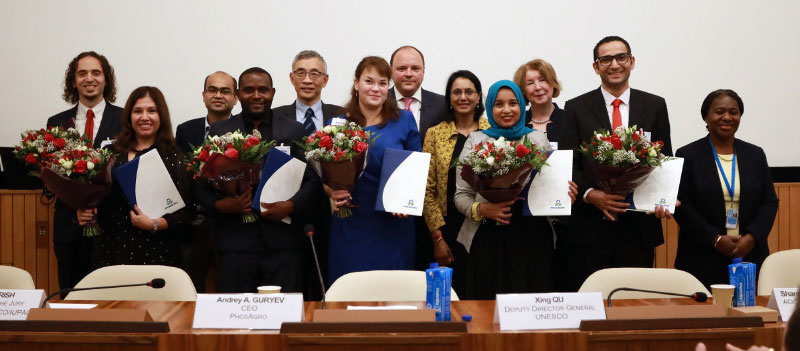
“Green Chemistry for Life” Program
In November 8, 2019, seven young scientists from around the world were awarded research grants provided by Green Chemistry for Life, a joint program from UNESCO, International Union of Pure and Applied Chemistry (IUPAC), and the PhosAgro Group. The award ceremony took place at UNESCO Headquarters in Paris.
The Green Chemistry for Life program was launched in 2014. Since then, a panel of judges consisting of 13 prominent scientists from 11 countries has reviewed over 700 applications submitted by young researchers in the field of green chemistry. The applicants come from Europe, Africa, Asia, Latin America, and the Middle East — 40 of whom have already received grants. In order to participate in the competition, young scientists are required to conduct research in the areas of healthcare, environmental protection, energy efficiency, and sustainable natural resource management.
In 2019, the awards ceremony was timed to coincide with World Science Day, celebrated annually at the beginning of November. The grant certificates were presented by Assistant Director-General Shamila Nair-Bedouelle; Deputy Director-General Xing Qu; Director of UNESCO’s Division of Science Policy and Capacity-Building Peggy Oti-Boateng; Director of the Institute of Chemistry and Problems of Sustainable Development at the Dmitry Mendeleev University of Chemical Technology of Russia and Past President of IUPAC Natalia Tarasova; Chair of the IUPAC Committee on Green Chemistry for Sustainable Development, professor at Ca’ Foscari University of Venice Pietro Tundo; Chair of the International Scientific Jury of the Green Chemistry for Life project, professor at the School of Chemistry at Trinity College of the University of Dublin John Corish; Chair of the International Scientific Board of UNESCO’s International Basic Sciences program Nicole Moreau, and PhosAgro CEO and a member of the Commission of the Russian Federation for UNESCO — Andrey Guryev.
In 2016, Russian scientist Alsu Akhmetshina became one of the Green Chemistry for Life grant recipients, which enabled her to expand her research on possible methods of reducing the negative environmental impact of polymer waste. In 2019, Galina Kalashnikova, a young Russian researcher at Kola Science Center of the Russian Academy of Sciences, received the grant. This funding will allow Kalashnikova the opportunity to develop the technology for producing unique titanium and silicate materials from waste. These materials can be used in medicine, industry, and particularly in creating lithium batteries that absorb toxic and hazardous substances.
The other young grantees’ research projects are no less interesting and promising. For instance, Abu Ashfaqur Sajib of Bangladesh is working on the development of multi-functional enzymes for converting wastes into biofuels. Sarah Abdel Gaber of Egypt is developing ways of using nanotechnologies to diagnose and treat liver cancer with algae extracts that are harmful to bodies of water.
Among other 2019 Green Chemistry for Life grant winners are Jesús Campos Manzano (Spain), Maria Antonieta Fernandez-Herrera (Mexico), Wilbert Mtangi (Zimbabwe), and Hamdy Maamoun Abdel-Ghafar Hefny (Egypt). There is no doubt that the academic world will hear these names again and again. The Green Chemistry for Life program will last until 2022.
Natalia Semioshina
